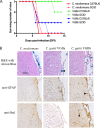Cryptococcus strains with different pathogenic potentials have diverse protein secretomes
- PMID: 25841021
- PMCID: PMC4452572
- DOI: 10.1128/EC.00052-15
Cryptococcus strains with different pathogenic potentials have diverse protein secretomes
Abstract
Secreted proteins are the frontline between the host and pathogen. In mammalian hosts, secreted proteins enable invasive infection and can modulate the host immune response. Cryptococcosis, caused by pathogenic Cryptococcus species, begins when inhaled infectious propagules establish to produce pulmonary infection, which, if not resolved, can disseminate to the central nervous system to cause meningoencephalitis. Strains of Cryptococcus species differ in their capacity to cause disease, and the mechanisms underlying this are not well understood. To investigate the role of secreted proteins in disease, we determined the secretome for three genome strains of Cryptococcus species, including a hypovirulent and a hypervirulent strain of C. gattii and a virulent strain of C. neoformans. Sixty-seven unique proteins were identified, with different numbers and types of proteins secreted by each strain. The secretomes of the virulent strains were largely limited to proteolytic and hydrolytic enzymes, while the hypovirulent strain had a diverse secretome, including non-conventionally secreted canonical cytosolic and immunogenic proteins that have been implicated in virulence. The hypovirulent strain cannot establish pulmonary infection in a mouse model, but strains of this genotype have caused human meningitis. To directly test brain infection, we used intracranial inoculation and found that the hypovirulent strain was substantially more invasive than its hypervirulent counterpart. We suggest that immunogenic proteins secreted by this strain invoke a host response that limits pulmonary infection but that there can be invasive growth and damage if infection reaches the brain. Given their known role in virulence, it is possible that non-conventionally secreted proteins mediate this process.
Copyright © 2015, American Society for Microbiology. All Rights Reserved.
Figures


References
-
- Naglik JR, Moyes D, Makwana J, Kanzaria P, Tsichlaki E, Weindl G, Tappuni AR, Rodgers CA, Woodman AJ, Challacombe SJ, Schaller M, Hube B. 2008. Quantitative expression of the Candida albicans secreted aspartyl proteinase gene family in human oral and vaginal candidiasis. Microbiology 154:3266–3280. doi:10.1099/mic.0.2008/022293-0. - DOI - PMC - PubMed
Publication types
MeSH terms
Substances
LinkOut - more resources
Full Text Sources

